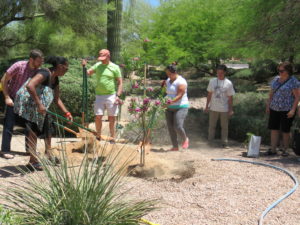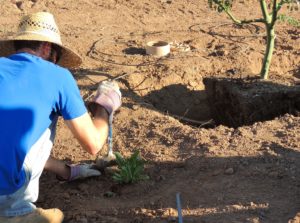





Saving Water Outdoors
Planting Trees and Shrubs
Trees, shrubs, and other landscape ornamentals are an easy way to enhance the value and appearance of your home. When planted in the right place and cared for properly, trees and other plants help increase property value, provide shade, and conserve energy. Of course, we fully expect you’re planting low-water use plants that you’ve selected from our Low-Water Use Plants page.
Consider Sun, Shade and Frost
Research the plant or read the plant tag to determine the amount of sunlight needed. Whether the exposure is full sun, partial shade, or full shade will determine which plants can grow successfully. Reflected heat from walls may be too extreme for many plants, including some desert natives. Likewise, cold air collects in low areas of your yard, where frost-sensitive plants may be damaged.
Height and Width
Before planting, consider the eventual height and width of the plant. How big will the tree or shrub be in 10 to 15 years? Many trees grow to overpower or can even cause damage to homes or nearby walls. Placing the ‘right plant in the right place’ will prevent continual maintenance or replacement.
Sometimes, Smaller is Better
Most people like the idea of super-sizing their shrubs from the nursery. But if you go smaller, you’ll save big – not only on nursery costs, but also on water bills. A less expensive one-gallon plant can quickly catch up to a five-gallon plant. Nearly all trees and shrubs come from the nursery as container-grown. Container sizes from 1- to 15-gallons are economical and the most commonly available, with 24-inch boxes or larger seen occasionally.
Consider Soil Conditions and Temperature
Soils in the Southwest are typically alkaline (salty) with a pH of near 8, a high clay content, and low organic matter. The low humidity levels and high air temperatures cause moisture to evaporate rapidly here. Look for plants that can tolerate these soil conditions and temperature extremes.
When to Plant: September to April is Ideal!
Although year-round planting in the Southwest is possible, the ideal planting time is from fall through spring, although spring is best for frost-sensitive species. Roots grow throughout the cooler months, allowing the plants to get established before the onset of summer heat.
Dig the Hole: Not a Path to China
The old nurseryman’s saying, “dig a $40 hole for a $20 tree,” is not just a cliché. To reach its fullest potential, a new plant needs room, so now is not the time to cut corners. The following recommendations by university researchers can bring planting success.
Before Digging – Apply water to the digging area several days in advance to make digging much easier. The soil should be moist, but not wet or sticking to the shovel or garden fork. Call your local Blue Stake (811) to find the location of utility lines prior to digging holes.
Till the Soil – Till or loosen soil four to five times the diameter and no deeper than the root ball. Roots that absorb water and nutrients grow rapidly in this area allowing your plant to establish quickly.
Size of the Hole – Remove soil in the center to create a hole twice as wide but only as deep as the root ball. Leaving the bottom of the hole flat and compacted prevents sinking, which can bury the stem or trunk.
Water Drainage – Check drainage by filling the hole with water. If water can penetrate the soil, so can plant roots. If water has not drained in 24 hours, a chimney can be added for proper drainage.
Soil – Caliche is a concrete-like soil deposit that occurs in the Southwest. These layered deposits of calcium carbonate restrict roots, increase soil salinity, impede drainage, and reduce a plant’s ability to take up iron (an essential nutrient). If your soil contains caliche, break up the layer or remove as many large pieces as possible. A drainage chimney can be added to the planting hole, if necessary.
Removing the Container – Handle the plant by the container, or gently by the root ball, not the trunk or branches. Remove the plant from the container with minimal disturbance to the root ball by placing the container on its side and tapping the sides and bottom with a hammer or other blunt object. This will usually free the walls allowing you to gently slide out the root ball.
Preparing the Root Ball – If roots are matted or circling, score the root ball with a utility knife by cutting lengthwise one inch deep in two or three places, trimming any circling roots.
Placing the Plant in the Hole – The top of the root ball should slightly above the existing soil surface.
Direction of the Plant – Turn the tree or shrub to face the desired direction. Cacti are often marked to indicate their south side – you should maintain this alignment in your landscape.
Filling the Hole – Before filling the hole, make sure that the plant is at the same level as it was in its container. Do not pile soil up on the stem or trunk and DO NOT plant too deep. No amendments or fertilizer are necessary at this time. Recent university research recommends refilling the planting hole with the native soil originally removed when digging the planting hole. The result will be a stronger root system and healthier plant.
Post-Planting Checklist: Heading Toward Home Base
Don’t stop now, you’re almost done! Following the steps below can ensure success, allowing your new plant to become a beautiful and healthy addition to your landscape for years to come:
Pruning is not recommended, except to remove dead or broken branches. Allowing lower branches to remain on trees for the first year promotes strong trunks and healthy growth – it also reduces the risk of sunburn. Use bypass pruners, which leave a clean cut. Avoid sealants; leave the wound exposed to the air and the plant will heal itself. Never cut the top off (called topping) a tree. This creates a huge wound resulting in an unsightly and unhealthy tree as well as creating new weakly attached growth.
Staking a newly planted tree is only necessary if it can’t stand on its own without support. Find details in our blog about staking. Inspect and loosen wires periodically as the tree grows. If you’re in an area with high winds, consider staking any new tree. Stakes should be removed after the first year. Find details in our blog about staking.
Fertilizing a newly planted tree or shrub is often debated. Plants from wholesale growers receive abundant fertilizer making the addition of more at planting time unnecessary. Some plants never need fertilizer – like most desert trees, cacti, and other natives. Wait at least one year after planting to apply fertilizer to other perennial landscape plants.
Watering is not optional. You must water well when planting. Create an area around the plant to collect water by building up a ridge of soil two to three inches high to serve as a water collection basin. If you have a drip irrigation system, place emitters over the root ball or simply let a hose trickle in the basin. Apply enough water to thoroughly wet the soil to the depth of the root ball and a little beyond. This will remove air pockets without compacting the soil. Remember that as your plant grows, the drip emitters should be moved away from the stem or trunk to below the tips of the branches or “drip line.” Learn more in our watering guide.
Mulch, mulch, mulch! Mulching is simply applying a two- to four-inch layer of organic material on top of the soil, keeping it away from the stem or trunk. This slows evaporation and keeps the soil cooler, which is important for tender feeder roots located just below the soil surface. And, as an added bonus, organic mulch adds nutrients back into the soil as it decomposes. Learn more on our page about mulching.



